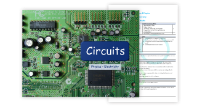Circuits - Circuit Symbols

Science Resource Description
In the study of electrical circuits, it is essential to understand and utilise standard circuit symbols to represent various components within a circuit diagram. These symbols are universally recognised, allowing for clear communication and interpretation of circuit designs. A 'bulb' is depicted as a simple circle with a cross inside, symbolising a light-emitting component. The 'cell' is represented by one long and one short parallel line, indicating a single unit of power supply, whereas a 'battery' is shown by several long and short lines, denoting a combination of multiple cells providing a greater voltage.
Other fundamental symbols include the 'switch', which is illustrated as a break in the line with a connecting angle, indicating the control mechanism for the flow of current. A 'buzzer', used to indicate sound output in a circuit, is represented by a set of small lines radiating from a semi-circle. The 'motor', a device that converts electrical energy into mechanical motion, is shown as a circle with the letter 'M' inside. Lastly, 'wire' connections, which facilitate the flow of electric current between components, are depicted as straight lines connecting the symbols within the circuit diagram. Understanding these symbols is crucial for anyone looking to construct or analyse electrical circuits.






